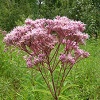
So many credible books on native North American flora often share the same story about Joe Pye yet seldom provide sourced information. Was Joe Pye a real person and if so, who was he?
Many websites and books refer to Joe Pye as being a Native medicine man from Salem, Massachusetts who earned his fame from curing colonial settlers of typhus using his eponymous healing herb. Some sources state that Joe Pye was a phonetic translation of jopi or jopai.
The first known use of the term Joe Pye as a common name for a plant was in 1818. Joe Pye appeared in Manual of Botany, for the Northern and Middle States of America: 2nd edition, a widely distributed publication authored by the famous New England geologist and botanist, Amos Eaton.
Eaton directly stated that Joe Pye is taken from the “name of an Indian,” not a white man posing as one. He understood that the use of the plant was that of a diaphoretic (sweat inducer) in western Massachusetts—not in Salem on the eastern seaboard as the Joe Pye legend of today states.
In the Manual of Botany, Eaton wrote that President Zephaniah Swift Moore of Williams College used an herbal tea made from one or both of the Eupatorium species listed by Eaton to treat his own fever. Moore was president of the college from 1815 to 1821. In 1817, Amos Eaton delivered a series of lectures there on botany and geology. Likely, it was during this time that Eaton learned of Moore’s success in treating fever with the liberal use of Joe Pye weed.
Before Eaton’s Manual of Botany, and for a time afterward, the popular names for Empatorium purpureum were Trumpet Weed, Gravel Root, Gravelweed, Purple Boneset, Purple Thoroughwort, and Queen of the Meadow. Today these names are rarely in use and Joe Pye has become the preferred common term.
There’s so much more information about the legend behind the name of Joe Pye weed. If you’re interested in learning more, then please visit the University of Michigan.




Very interesting. I’d heard of Joe Pye weed, but had no idea about it’s use or the origin of the name.
Great article. I have recently become interested in wild plant and enjoy reading about legends and history surrounding them.
I am interested in learning more about the name behind the legend. The link in the last paragraph above does not work. Can you forward me a good link?
“There’s so much more information about the legend behind the name of Joe Pye weed. If you’re interested in learning more, then please visit the Prairie Works article entitled Joe Pye – The Name Behind the Legend.”
Many thanks.
I’m really enjoying the design and layout of your site.
It’s a very easy on the yes which akes it much more enjoyable
for me to come here and visit more often. Did you hire out a designer to create your
theme? Great work!
That was a good article but has been taken down. Too bad; it was quite well researched. Basically, it proved without question that Joe Pye was an Indian medicine man at the original Stockbridge Reservation in northwestern Ma, practicing c. 1750-80. He was a student of Samuel Occom, a pagan Indian who converted to Christianity and was very influential among the NE and NY Indians c. 1750 in converting them as well. He was also a medicine man and learned over 45 herbs from a medicine man at Montauk on Long Island. His herb journal is in the collections of Dartmouth College, which was founded on money basically stolen from him—he lectured in the UK to raise money to found an Indian college and instead they took it and founded Dartmouth and wouldn’t let Indians in. He was an important minister in the “great awakening” (i.e., fundamentalist tent revivals). The Stockbridge Indians sided with the Americans in the Revolution and like many people in the upper Hudson and western MA areas were decimated by war. They were also coming under pressure from white settlers and MA refused to protect their reservation. They sold out, moved to Brotherton, I think, in NY, and on to the Stockbridge Rez in central WI, where they still are today. A small unregistered band still lives in North Granville, NY, a couple dozen miles NW of the original Rez. Joe Pye is mentioned frequently in the records. He was the son of “Ole Joe Pye” and the original name may have been Ashpee (“high hill, eminence”). See BIA rolls. Descendants of Occom and Pye still live in Wisconsin. The article also showed that the Salem information was incorrect. However, Joe Pye lived c. 1720-1800 and could not have directly helped Dr. Zachariah Moore, the President of Williams College, as per Eaton’s botany book, so there is some glitch in the story. This from memory; I may have a few facts slightly incorrect.
Thank you Matthew for sharing this great information, it is greatly appreciated! Learning historical information about plants, including their common name origins, is something I find quite fascinating.
Hi my family member! I wish to say that this post iis awesome, great written and
come with approximately all significant infos.
I’d like to look extra posts like this.